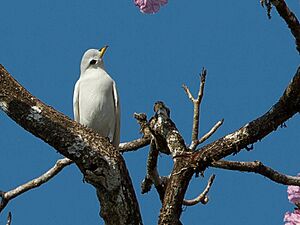Yellow-billed cotinga facts for kids
Quick facts for kids Yellow-billed cotinga |
|
|---|---|
 |
|
| Conservation status | |
| Scientific classification | |
| Genus: |
Carpodectes
|
| Species: |
antoniae
|
 |
|
The yellow-billed cotinga (Carpodectes antoniae) is a beautiful bird found in the family Cotingidae. These birds live in the low-lying areas along the Pacific coast of Costa Rica and Panama. You can find them in warm, wet forests, especially in mangrove forests, and also in bushy areas. Sadly, their homes are disappearing, which puts them at risk.
Contents
What Does the Yellow-Billed Cotinga Look Like?
The yellow-billed cotinga grows to be about 20 centimeters (8 inches) long. Male birds have a pure white body, just like the snowy cotinga. However, the top of their head has a soft, pearly-grey color. The easiest way to tell them apart is their beak: the yellow-billed cotinga has a bright yellow beak, while the snowy cotinga has a bluish-grey one.
Female yellow-billed cotingas look similar to female snowy cotingas. Their upper feathers are a pale brownish-grey, and their belly is greyish-white. Just like the males, the females also have a yellow beak.
Where Do Yellow-Billed Cotingas Live?
The yellow-billed cotinga lives only along the Pacific coast of Costa Rica and a tiny part of western Panama. They are found in a few small, separate areas. One of the northernmost spots in Costa Rica is near the mouth of the Tárcoles River and in the nearby Carara National Park.
The largest groups of these birds live around the Golfo Dulce and the Osa Peninsula. Their main nesting area is at the mouth of the Sierpe River. While they are mostly found in mangrove forests, you might also see them in bushy areas or nearby lowland forests. Sometimes, they even appear in single trees in open fields.
How Do Yellow-Billed Cotingas Behave?
Scientists haven't studied the behavior of the yellow-billed cotinga very much yet. We do know that male birds, and sometimes females, like to perch high in trees near the Sierpe River. From there, they fly back and forth low over the water.
People have also seen them perform a special swooping flight. This might be a way for them to attract a mate during courtship.
Why Are Yellow-Billed Cotingas Endangered?
Even though no one has counted every single bird, experts believe there are only about 150 to 700 adult yellow-billed cotingas left. Sadly, their numbers are going down. The biggest danger they face is the loss of their mangrove forest homes.
These forests are being cut down to make space for shrimp farms, cattle pastures, and rice fields. Also, many lowland forests near the mangroves have been cleared. Building roads and walls has also changed how water flows in the area. Because of these threats, the International Union for Conservation of Nature has listed the yellow-billed cotinga as "Near Threatened." This means they are at risk of becoming endangered if things don't change.



